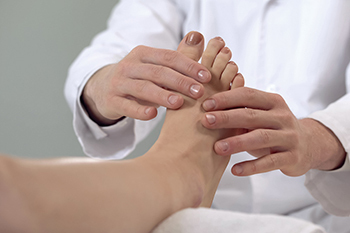
Cuboid syndrome is a foot condition that can occur when the cuboid bone moves out of alignment. This can happen as a result of an acute injury or can gradually become misplaced as the aging process occurs. It can be more common among athletes and dancers than in the rest of the population and is generally triggered by physical activity. Pain and discomfort with cuboid syndrome are felt on the outside of the foot and the pain may be relieved when the weight is taken off the foot. Additional symptoms of this condition can include a limited range of motion in the foot and ankle and there may be bruising and swelling on the sole of the foot. People who have an abnormal foot structure like flat feet may be prone to developing cuboid syndrome. Additionally, patients who are obese, people who run on uneven surfaces, and wearing shoes that do not fit correctly may be possible causes of cuboid syndrome. Mild relief can come frequently resting the foot, and temporarily stopping the activity that may have caused this condition. This is a foot condition that is treated by a podiatrist, and it is suggested that you contact one for permanent treatment options if you are afflicted with cuboid syndrome.
Cuboid syndrome, also known as cuboid subluxation, occurs when the joints and ligaments near the cuboid bone in the foot become torn. If you have cuboid syndrome, consult with Dr. Kevin Davis from Davis Foot & Ankle Centers. Our doctor will assess your condition and provide you with quality foot and ankle treatment.
Cuboid syndrome is a common cause of lateral foot pain, which is pain on the outside of the foot. The condition may happen suddenly due to an ankle sprain, or it may develop slowly overtime from repetitive tension through the bone and surrounding structures.
Causes
The most common causes of cuboid syndrome include:
- Injury – The most common cause of this ailment is an ankle sprain.
- Repetitive Strain – Tension placed through the peroneus longus muscle from repetitive activities such as jumping and running may cause excessive traction on the bone causing it to sublux.
- Altered Foot Biomechanics – Most people suffering from cuboid subluxation have flat feet.
Symptoms
A common symptom of cuboid syndrome is pain along the outside of the foot which can be felt in the ankle and toes. This pain may create walking difficulties and may cause those with the condition to walk with a limp.
Diagnosis
Diagnosis of cuboid syndrome is often difficult, and it is often misdiagnosed. X-rays, MRIs and CT scans often fail to properly show the cuboid subluxation. Although there isn’t a specific test used to diagnose cuboid syndrome, your podiatrist will usually check if pain is felt while pressing firmly on the cuboid bone of your foot.
Treatment
Just as the range of causes varies widely, so do treatments. Some more common treatments are ice therapy, rest, exercise, taping, and orthotics.
If you have any questions, please feel free to contact our office located in Springfield, TN . We offer the newest diagnostic and treatment technologies for all your foot care needs.
